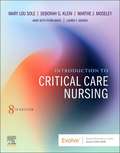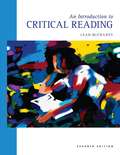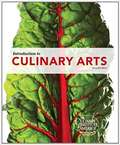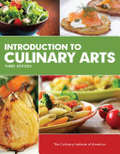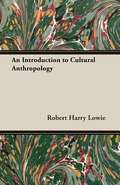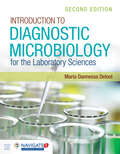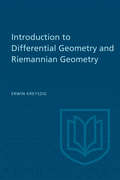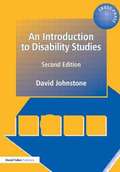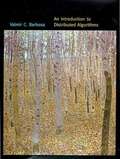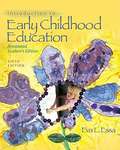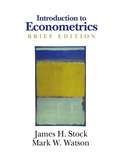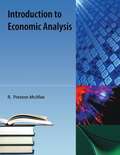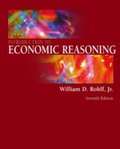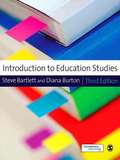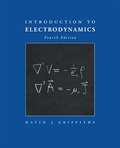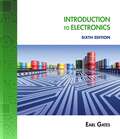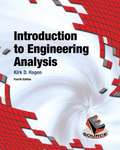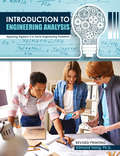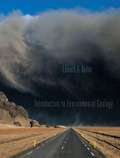- Table View
- List View
Introduction To Critical Care Nursing
by Mary Lou Sole Deborah Goldenberg Klein Marthe J. MoseleyStart here to master the concepts, technology, and procedures of critical care nursing! Introduction to Critical Care Nursing, 8th Edition prepares you to provide safe, effective, patient-centered care in a variety of high-acuity, progressive, and critical care settings. Evidence-based coverage includes realistic case studies and incorporates the latest advances in critical care. Disorders are conveniently organized by body system or special situation, and nursing management chapters include quick-reference nursing care plans. This clear, concise textbook will help you develop the knowledge and clinical reasoning skills needed for success in today's highly complex critical care environments.
An Introduction to Critical Reading
by Leah MccraneyThis unique college reading text gives students experience reading and evaluating poetry, short stories, essays, and textbook chapters. An innovative Instructor's Manual gives instructors a wealth of teaching ideas and background material on each piece with a focus on critical thinking.
Introduction to Culinary Arts
by Jerry Gleason Institute of America Culinary Art StaffIntroduction to Culinary Arts, Second Edition, covers everything from culinary theory and management to sanitation and safety to nutrition and food science to culinary and baking techniques, instilling practical knowledge and skills that students can apply throughout their career.
Introduction to Culinary Arts, Student Edition
by The Culinary Institute of AmericaNIMAC-sourced textbook <P><P>The Culinary Institute of America, a leader in culinary excellence for over 60 years, takes your high school students through a journey from a culinary arts student through employability. Introduction to Culinary Arts provides a solid foundation in culinary arts with a wealth of features that spotlight the important information. This powerful text also addresses culinary management and business skills.
Introduction to Design
by Alan PipesFrom the author of Production for Graphic Designers 3e, this book provides an engaging introduction to the fundamentals of art and design. With a wide range of illustrations, Alan Pipes demonstrates in Part 1 (Elements) how an artist or designer fills a blank canvas, nothingness, with points, lines, shapes, textures, and colors in order to create a sense of space, time, and motion. Part 2 (Rules) reveals how to develop unity and harmony, balance, scale, and proportion, contrast and emphasis, and rhythm-all in the quest for a satisfying illusion. In addition, the author demonstrates his formidable knowledge of computer-aided art and design, supplementing it with his own color or black-white diagrams. This book is ideal for students embarking on courses in graphic design, fine art, and illustration-as well as allied courses in interior design, fashion design, textile design, industrial design, product design, and printmaking.
Introduction to Diagnostic Microbiology for the Laboratory Sciences
by Maria Dannessa DelostIntroduction to Diagnostic Microbiology for the Laboratory Sciences, Second Edition provides a concise study of clinically significant microorganisms for the medical laboratory student and laboratory practitioner.
Introduction to Differential Geometry and Riemannian Geometry (Mathematical Expositions #16)
by Erwin KreyszigThis book provides an introduction to the differential geometry of curves and surfaces in three-dimensional Euclidean space and to n-dimensional Riemannian geometry. Based on Kreyszig's earlier book Differential Geometry, it is presented in a simple and understandable manner with many examples illustrating the ideas, methods, and results.<P><P> Among the topics covered are vector and tensor algebra, the theory of surfaces, the formulae of Weingarten and Gauss, geodesics, mappings of surfaces and their applications, and global problems. A thorough investigation of Reimannian manifolds is made, including the theory of hypersurfaces. <P> Interesting problems are provided and complete solutions are given at the end of the book together with a list of the more important formulae. Elementary calculus is the sole prerequisite for the understanding of this detailed and complete study in mathematics.
Introduction to Disability Studies
by David JohnstoneAn introductory text that explores the current issues in the lives and circumstances of disabled people, their careers, and those who intend to work in the caring services. Explores and analyzes quality of life factors, the emergence of rights, and the strengths and weakness of community care provisions. Also provides examples of individual oppressions and success stories, and suggests how disabled and non-disabled people can collaborate in the development of inclusive communities and neighborhoods. Distributed by Taylor & Francis. Annotation c. by Book News, Inc., Portland, OR.
An Introduction to Distributed Algorithms
by Valmir C. BarbosaAn Introduction to Distributed Algorithms takes up some of the main concepts and algorithms, ranging from basic to advanced techniques and applications, that underlie the programming of distributed-memory systems such as computer networks, networks of workstations, and multiprocessors. Written from the broad perspective of distributed-memory systems in general it includes topics such as algorithms for maximum flow, program debugging, and simulation that do not appear in more orthodox texts on distributed algorithms. Moving from fundamentals to advances and applications, ten chapters--with exercises and bibliographic notes--cover a variety of topics. These include models of distributed computation, information propagation, leader election, distributed snapshots, network synchronization, self- stability, termination detection, deadlock detection, graph algorithms, mutual exclusion, program debugging, and simulation. All of the algorithms are presented in a clear, template- based format for the description of message-passing computations among the nodes of a connected graph. Such a generic setting allows the treatment of problems originating from many different application areas. The main ideas and algorithms are described in a way that balances intuition and formal rigor--most are preceded by a general intuitive discussion and followed by formal statements as to correctness complexity or other properties.
Introduction to Early Childhood Education (6th Edition, Annotated Student’s Edition)
by Eva L. EssaThe book provides a comprehensive overview of early childhood education that is solidly based on current research and theories. The text, inter alia, examines curriculum and the fostering of creativity, as well as physical, cognitive, language, and social development--and every facet of early childhood education is examined and explained. This extensively revised edition includes new standards and accountability in the field of early childhood education.
Introduction to Econometrics: Principles and Applications (3rd Edition)
by Harry H. Kelejian Wallace E. OatesIntroduction To Econometrics: Principles And Applications
Introduction To Econometrics (Brief Edition)
by James H. Stock Mark W. WatsonIn keeping with their successful introductory econometrics text, Stock and Watson motivate each methodological topic with a real-world policy application that uses data, so that readers apply the theory immediately. Introduction to Econometrics, Brief, is a streamlined version of their text, including the fundamental topics, an early review of statistics and probability, the core material of regression with cross-sectional data, and a capstone chapter on conducting empirical analysis. Introduction and Review: Economic Questions and Data; Review of Probability; Review of Statistics. Fundamentals of Regression Analysis: Linear Regression with One Regressor; Regression with a Single Regressor: Hypothesis Tests and Confidence Intervals in the Single-Regressor Model; Linear Regression with Multiple Regressors; Hypothesis Tests and Confidence Intervals in the Multiple Regressor Model; Nonlinear Regression Functions; Assessing Studies Based on Multiple Regression; Conducting a Regression Study Using Economic Data. MARKET: For all readers interested in econometrics.
Introduction to Economic Analysis
by R. Preston McafeeThis book presents introductory economics ("principles") material using standard mathematical tools, including calculus. It is designed for a relatively sophisticated undergraduate who has not taken a basic university course in economics. It also contains the standard intermediate microeconomics material and some material that ought to be standard but is not. The book can easily serve as an intermediate microeconomics text. The focus of this book is on the conceptual tools and not on fluff. Most microeconomics texts are mostly fluff and the fluff market is exceedingly over-served by $100+ texts. In contrast, this book reflects the approach actually adopted by the majority of economists for understanding economic activity. There are lots of models and equations and no pictures of economists.
Introduction to Economic Analysis
by R. Preston Mcafee Tracy R. LewisThis book presents standard intermediate microeconomics material and some material that, in the authors' view, ought to be standard but is not. Introductory economics material is integrated. Standard mathematical tools, including calculus, are used throughout. The book easily serves as an intermediate microeconomics text, and can be used for a relatively sophisticated undergraduate who has not taken a basic university course in economics. The focus of this book is on the conceptual tools and not on fluff. As such, it reflects the approach actually adopted by the majority of economists for understanding economic activity. There are lots of models and equations, and no pictures of economists ;-) Economic analysis is used in many situations. When British Petroleum sets the price for Alaskan crude oil, it uses an estimated demand model, both for gasoline consumers and also for the refineries to which BP sells. Economic analysis was used by experts in the antitrust suit brought by the U.S. Department of Justice both to understand Microsoft s incentive to foreclose (eliminate from the market) rival Netscape and consumer behavior in the face of alleged foreclosure. Stock market analysts use economic models to forecast the profits of companies to predict the price of their stocks. When the government forecasts the budget deficit or considers a change in environmental regulations, it uses economic models. This book presents the building blocks of the models in common use by an army of economists thousands of times per day. This book, plus econometrics, provides most of the economic analysis tools to take upper division economics courses of any type.
Introduction to Economic Analysis
by R. Preston Mcafee Tracy R. LewisThis book presents standard intermediate microeconomics material and some material that, in the authors' view, ought to be standard but is not. Introductory economics material is integrated. Standard mathematical tools, including calculus, are used throughout. The book easily serves as an intermediate microeconomics text, and can be used for a relatively sophisticated undergraduate who has not taken a basic university course in economics. The focus of this book is on the conceptual tools and not on fluff. As such, it reflects the approach actually adopted by the majority of economists for understanding economic activity. There are lots of models and equations, and no pictures of economists ;-) Economic analysis is used in many situations. When British Petroleum sets the price for Alaskan crude oil, it uses an estimated demand model, both for gasoline consumers and also for the refineries to which BP sells. Economic analysis was used by experts in the antitrust suit brought by the U.S. Department of Justice both to understand Microsoft s incentive to foreclose (eliminate from the market) rival Netscape and consumer behavior in the face of alleged foreclosure. Stock market analysts use economic models to forecast the profits of companies to predict the price of their stocks. When the government forecasts the budget deficit or considers a change in environmental regulations, it uses economic models. This book presents the building blocks of the models in common use by an army of economists thousands of times per day. This book, plus econometrics, provides most of the economic analysis tools to take upper division economics courses of any type.
Introduction To Economic Reasoning
by William D. RohlfWith a goal of encouraging students to become informed decision-makers, Introduction to Economic Reasoning, Seventh Edition, provides a non-technical, concise introduction to basic economic theories that is ideal for a one-semester course. The Seventh Edition relates coherent explanations of general theories and models with thought-provoking, current features that apply and enliven core concepts. The hands-on economic reasoning approach promotes the idea that students can use economic analysis in their everyday lives to help them succeed in their careers and understand today's global economic issues.
Introduction to Education Studies
by Dr Steve Bartlett Dr Diana M BurtonEducation Studies is a broad, multi-disciplinary and rapidly growing field. Introduction to Education Studies has proven itself to be the key text for students of the subject for over a decade, leading readers through the field's key strands, concepts and applications without assuming any prior knowledge. <P><P> Bartlett and Burton provide first-time students and those engaged in more advanced aspects of the subject with all the tools that they need to approach Education Studies and also encourage a critical, questioning approach which will put them in good stead for further study and professional practice.<P> The new edition includes:<P> * A new chapter on globalisation and international comparative education <P> * A new companion website featuring online journal articles relating to each chapter <P> * More guidance on how to critique research <P> * More 'Reader Reflection' boxes, encouraging students to reflect on their own practice throughout <P> * A new framework for analysing policy <P> * New sections within the curriculum and the history of schooling chapters reflecting the latest UK developments<P> * Complete update of education policy issues <P> Additional online resources at www.uk.sagepub.com/bartlett3e<P> Also available are free journal articles accompanying each chapter of the book, enabling discussion and further reading to deepen students knowlege of each chapter subject.<P> Steve Bartlett is Professor of Education Studies at the University of Wolverhampton.<P> Diana Burton is Professor of Education and Pro Vice Chancellor at Liverpool John Moores University.
Introduction to Electrodynamics (4th Edition)
by David J. GriffithsFor junior/senior-level electricity and magnetism courses. This book is known for its clear, concise, and accessible coverage of standard topics in a logical and pedagogically sound order. The highly polished Fourth Edition features a clear, accessible treatment of the fundamentals of electromagnetic theory, providing a sound platform for the exploration of related applications (ac circuits, antennas, transmission lines, plasmas, optics, etc. ). Its lean and focused approach employs numerous new examples and problems.
Introduction To Engineering Analysis
by Kirk HagenFor use in the first-year engineering course. This text is also suitable for individuals interested in adopting a problem-solving approach to engineering problems. <P><P> The goal of this text is to introduce a general problem-solving approach for the beginning engineering student. Thus, Introduction to Engineering Analysis focuses on how to solve (any) kind of engineering analytical problem in a logical and systematic way. The book helps to prepare the students for such analytically oriented courses as statics, strength of materials, electrical circuits, fluid mechanics, thermodynamics, etc.
Introduction to Engineering Analysis: Applying Algebra II to Solve Engineering Problems
by Edmund TsangIntroduction to Engineering Analysis: Applying Algebra II to Solve Engineering Problems
Introduction to Environmental Geology Fifth Edition
by Edward A. KellerThis text focuses on helping non-science majors develop an understanding of how geology and humanity interact. Ed Keller--the author who first defined the environmental geology curriculum--focuses on five fundamental concepts of environmental geology: Human Population Growth, Sustainability, Earth as a System, Hazardous Earth Processes, and Scientific Knowledge and Values. These concepts are introduced at the outset of the text, integrated throughout the text, and revisited at the end of each chapter. The Fifth Edition emphasizes currency, which is essential to this dynamic subject, and strengthens Keller's hallmark "Fundamental Concepts of Environmental Geology," unifying the text's diverse topics while applying the concepts to real-world examples.
